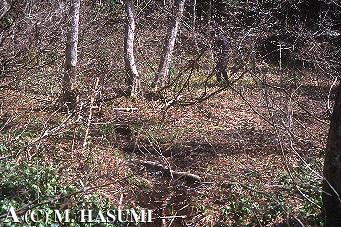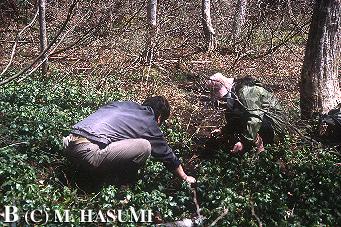

 |
 |
(A) One of two branched streams, the beginning of which was formed by penetration of subterranean water (photographed on 30 April 2005).
(B) A lower part of this stream (photographed on 30 April 2005). Two persons, looking for salamander individuals or egg sacs, were M. Kakegawa (left) and Y. Saikawa (right).
At the time of examination on 30 April 2005, 2 females of H. kimurae, more than 1 month after breeding activity ceased, were found under decaying logs above ground on land (soil pHs = 4.0-5.3). The two streams (water temperatures = 8.0-10.0 C, water pHs = 5.9-6.3) contained 2 males of H. hidamontanus with a typical aquatic-phase morph, and 1 pair of egg sacs just after deposition, as well as 1 juvenile of the frog Rana ornativentris. Increased head width, swollen body and cloacal region, an evident tubercle developed at the anterior angle of the vent, developed tailfin, and a white patch in the throat region (Hasumi, 2001) were characteristic of those males.
At the time of examination on 14 May 2005, 1 spent female of H. hidamontanus was found under a decaying log above ground on land. The two streams (air temperature = 16.5 C, water temperatures = 7.3-15.1 C, water pH = 6.1) involved 3 males with the distinctive aquatic-phase morph under deposited egg sacs, 1 overwintering larva, and a total of 15 pairs of egg sacs including 18-36 embryos between the blastopore stage and the early tail-bud stage (0-8 unfertilized eggs), the adhesive tips of which were attached to part of decaying twigs or roots of aquatic plants. The vegetal pole of these embryos assumed a mint green color, which was the same as that of embryos in Hynobius nigrescens (Hasumi, 1996). There were 2 slender males of the toad Bufo japonicus formosus having thumb pads (during spring-dormancy after the breeding season) and 1 juvenile of R. ornativentris in the streams.
Accompanied Research Collaborators (alphabetical order): Masaichi Kakegawa (Tokyo Metropolitan Komatsugawa Senior High School), and Fujio Kishi and Yuko Saikawa (Shirouma Association of Naturalists).